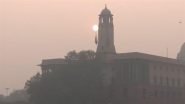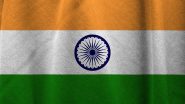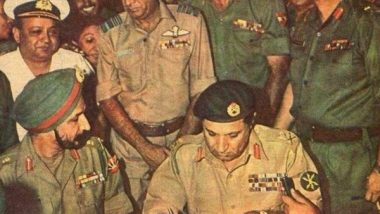New Delhi, December 16: In India, Vijay Diwas is observed on December 16 to commemorate India's decisive victory over Pakistan in the 1971 war, which resulted in East Pakistan's liberation and Bangladesh's birth. Know all about the history, significance and key facts of the day commemorating India's historic victory over Pakistan in the 1971 war. December 16, 1971, was the day when Pakistan signed the instrument of surrender in Dhaka following a 13-day India-Pakistan War. With the surrender of over 93,000 soldiers, Pakistan Army's capitulation against Indian forces was complete. Following this decisive victory, India announced itself as a significant regional force. Vijay Diwas 2022: When India Made 93,000 Pakistan Soldiers Surrender During 1971 War and Liberated Bangladesh.
Vijay Diwas 2022: Key Facts of The Day
The catalyst of the conflict was the struggle of the Bangladeshi people for Independence, West Pakistan's mistreatment of the Bangladeshi masses and the subversion of the outcomes of the elections in East Pakistan. The extensive genocide of the East Pakistani people committed by the authoritarian military government of Pakistan, led by General Yahya Khan, was another reason for the conflict. Vijay Diwas 2022: Know Date, History and Significance of the Day That Celebrates India’s Heroic Victory Over Pakistan During 1971 War.
East Pakistan made the formal request for succession on March 26, 1971.
The excesses carried out by the Pakistan army in East Pakistan have been very well documented. According to Lt Gen A A K Niazi, Commander Eastern Command and Chief Martial Law Administrator, his predecessor, Lt Gen Tikka Khan's policy was brutal - killing of civilians and scorching the earth. His order to the troops was: 'I want the land and not the people.' Major General Farman Ali and Brig. (later Lieutenant General) Jahanzeb Arbab carried out these orders faithfully. Farman had written in his table diary, 'Green land of East Pakistan will be painted red.' Niazi said: 'The military action was a display of stark cruelty, more merciless than the massacres at Bukhara and Baghdad by Changez Khan and Halaku Khan, or at Jallianwala Bagh by the British General Dyer.'
Under President Ayub Khan, a military decision was taken that 'the defence of the East lies in the West' based on the principle that if the military was split between the two wings, neither of them would have been able to resist the Indian army. Thus, a bigger portion of the Pakistan army was deployed in West Pakistan, and a much smaller force was kept in East Pakistan to defend the border. On December 3, 1971, Pakistan launched preventive airstrikes against 11 stations of the Indian Air Force. In all, thirty-two aircraft out of an inventory of 278 fighter planes took part in the initial strike that started between 5:09 pm and 5:23 pm but was unsuccessful.
Following this, the Indian Army was ordered to aid Bengali nationalist organisations in their fight for Bangladeshi independence in East Pakistan.
During his interrogation in India after the war, General Niazi said that Pakistan's strategy was centred on the premise that India had 'planned only a limited action' for establishing Bangladesh Government in East Pakistan. On the basis of this assessment, Pakistan deployed her forces thinly all along the border spread out over twenty-five hundred miles and ordered them to hold on at any cost. As a result, Pakistani troops were pinned down at the periphery. This enabled the Mukti Bahini to expand their sway inside East Pakistan. In reality, the Indian objective was not to capture a chunk of territory. Still, by the time this was realized, it was much too late for Pakistan to rectify its strategic mistake.
The Mukti Bahini insurgents in East Pakistan teamed up with Indian forces to combat Pakistani troops in the region. The Southern Command protected the nation's borders during the conflict from Pakistani aggression. The legendary battles of Longewala and Parbat Ali are among the conflicts fought in the Southern Army's operational region. Here, tenacious Indian troops decimated Pakistan's armoured forces.
India began Operation Trident on December 4, 1971. The Western Naval Command of the Indian Navy successfully launched a surprise attack on Karachi harbour during this operation. Trident served as the cover name for it.
A raid was conducted on the Pakistani town of Chachro by members of the legendary 10 Para Commando Battalion under the command of Lieutenant Colonel (later Brigadier) Bhawani Singh. These fights have made history and demonstrate our men's tenacity, bravery, and determination. A meeting with the governor of East Pakistan took place in a home on December 14 when the IAF struck the location. This strike left Pakistan reeling. Because of this, on December 16th, 1971, the process of surrender began.
The Surrender in East
Dacca fell without a fight even though barely twenty-four hours earlier, Niazi had defiantly told BBC that the army would fight to the last man. However, instead of any heroics, Niazi surrendered to the Indian army on 16 December and tamely signed the instrument of surrender in a formal public ceremony.
East Pakistan separated from Pakistan on December 16, 1971, and Bangladesh was born as a new country. The people of Pakistan heard the news of the surrender on 16 December through the Indian prime minister's broadcast over All India Radio. Radio Pakistan soft-pedalled the announcement of surrender in its 5 p.m. news bulletin in these memorable words: 'Following an arrangement between the commanders of India and Pakistan, fighting has ceased in the Eastern theatre, and the Indian troops have entered Dacca.'
Pakistan and the creation of Bangladesh was a devastating event for West Pakistan, the aftershocks of which continue to this day. Along with the physical fall of Dacca, Pakistan was also defeated psychologically. The two-nation theory that Muslims of the subcontinent formed a nation was demolished. Pakistan is still searching for a rationale for the dismemberment. In India, this battle is considered a historical occurrence. Because of this, December 16 is commemorated nationwide as "Vijay Diwas" to honour India's triumph over Pakistan. According to reports, 3,900 Indian soldiers are believed to have died, and 9,851 were injured during the battle of 1971.













 Quickly
Quickly





















